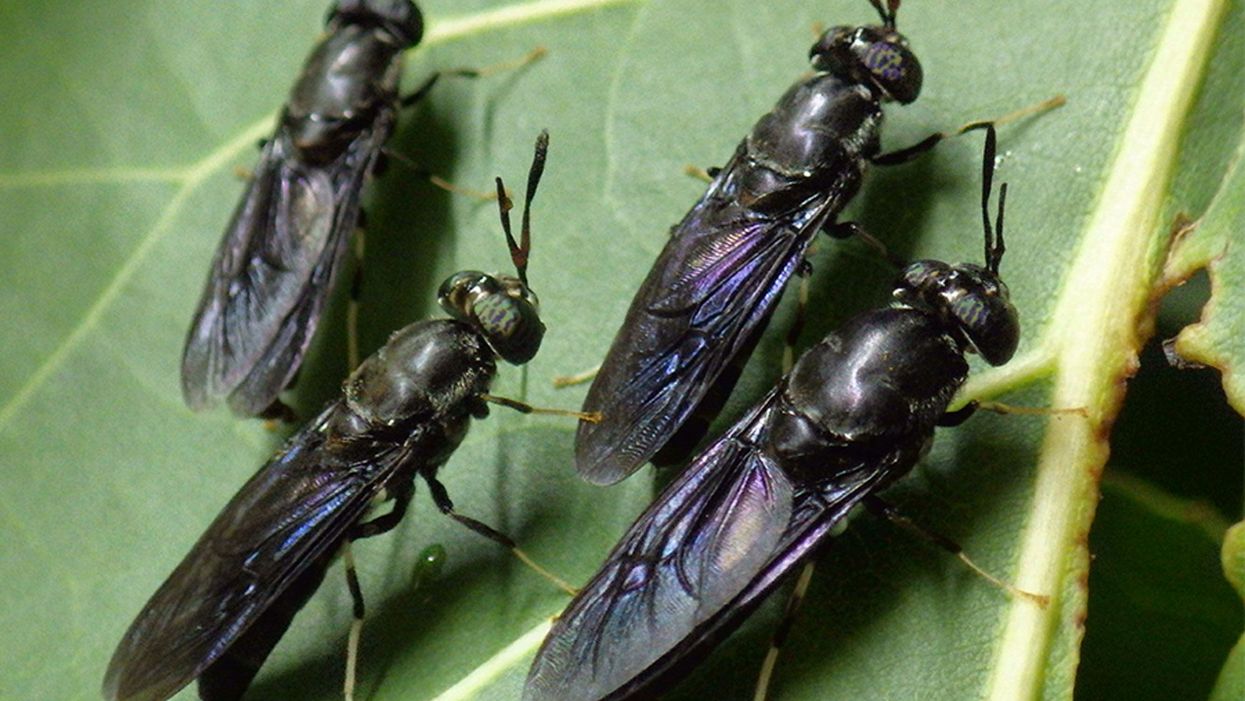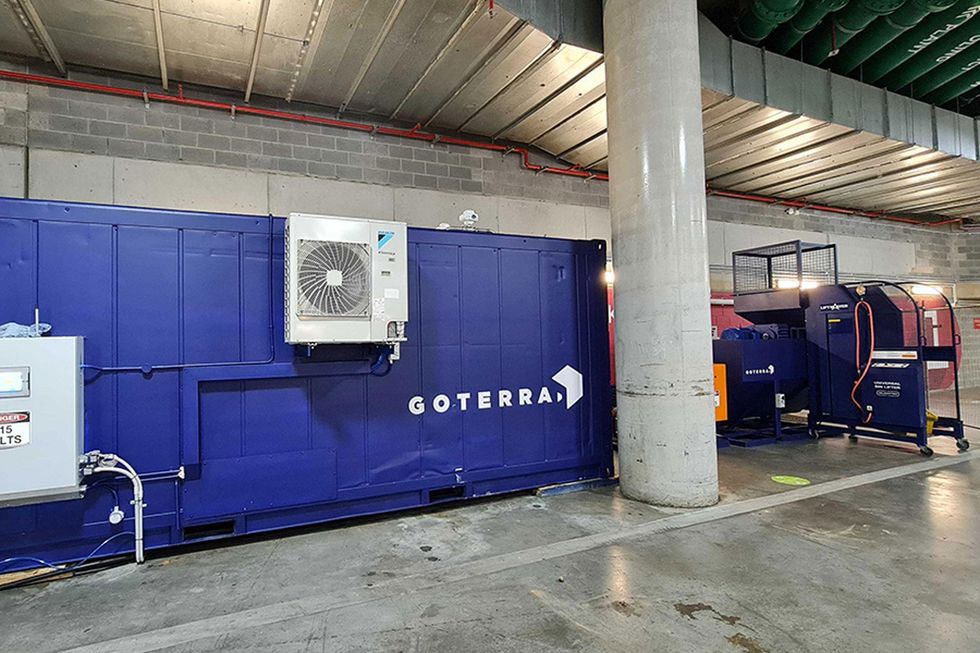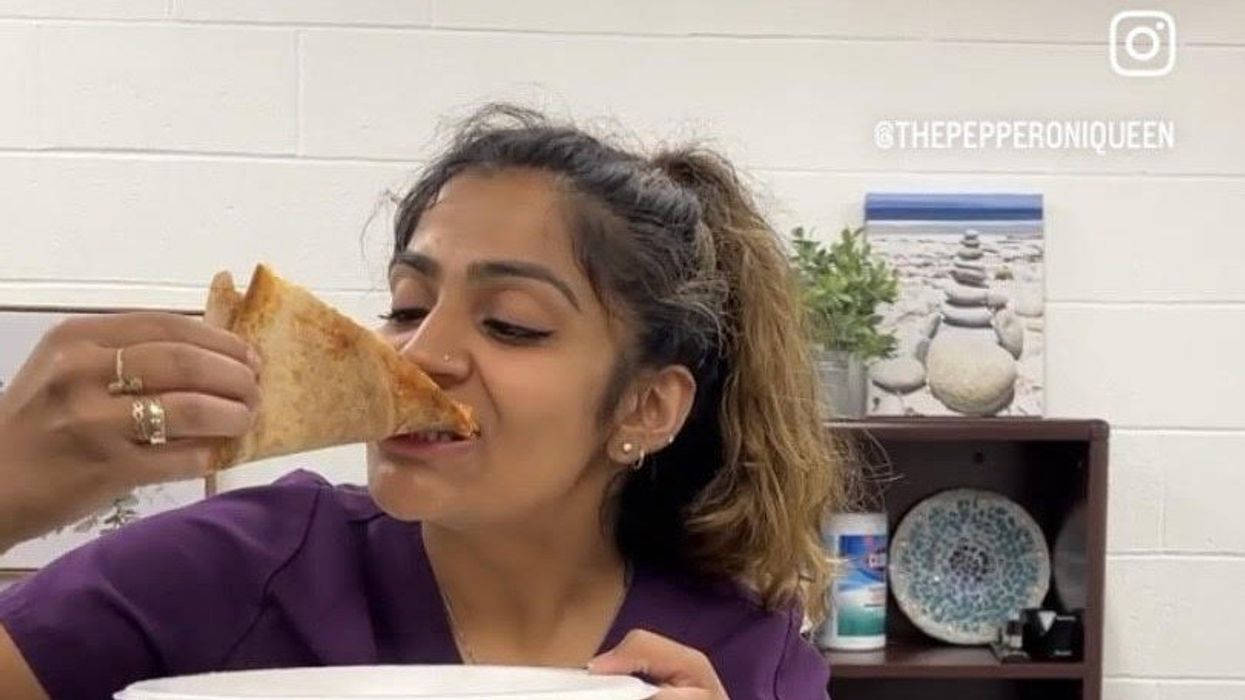Sustainable Urban Farming Has a Rising Hot Star: Bugs

The larvae of adult black soldier flies can turn food waste into sustainable protein with minimal methane gas emissions.
In Sydney, Australia, in the basement of an inner-city high-rise, lives a mass of unexpected inhabitants: millions of maggots. The insects are far from unwelcome. They are there to feast on the food waste generated by the building's human residents.
Goterra, the start-up that installed the maggots in the building in December, belongs to the rapidly expanding insect agriculture industry, which is experiencing a surge of investment worldwide.
The maggots – the larvae of the black soldier fly – are voracious, unfussy eaters. As adult flies, they don't eat, so the young fatten up swiftly on whatever they can get. Goterra's basement colony can munch through 5 metric tons of waste in a day.
"Maggots are nature's cleaners," says Bob Gordon, Head of Growth at Goterra. "They're a great tool to manage waste streams."
Their capacity to consume presents a neat response to the problem of food waste, which contributes up to 8% of global greenhouse gas emissions each year as it rots in landfill.
"The maggots eat the food fairly fresh," Gordon says. "So, there's minimal degradation and you don't get those methane emissions."
Alongside their ability to devour waste, the soldier fly larvae hold further agricultural promise: they yield an incredibly efficient protein. After the maggots have binged for about 12 days, Goterra harvests and processes them into a protein-rich livestock feed. Their excrement, known as frass, is also collected and turned into soil conditioner.
"We are producing protein in a basement," says Gordon. "It's urban farming – really sustainable, urban farming."

Goterra's module in the basement at Barangaroo, Sydney.
Supplied by Goterra
Goterra's founder Olympia Yarger started producing the insects in "buckets in her backyard" in 2016. Today, Goterra has a large-scale processing plant and has developed proprietary modules – in shipping containers – that use robotics to manage the larvae.
The modules have been installed on site at municipal buildings, hospitals, supermarkets, several McDonald's restaurants, and a range of smaller enterprises in Australia. Users pay a subscription fee and simply pour in the waste; Goterra visits once a fortnight to harvest the bugs.
Insect agriculture is well established outside of the West, and the practice is gaining traction around the world. China has mega-facilities that can process hundreds of tons of waste in a day. In Kenya, a program recently trained 2000 farmers in soldier fly farming to boost their economic security. French biotech company InnovaFeed, in partnership with US agricultural heavyweight ADM, plans to build "the world's largest insect protein facility" in Illinois this year.
"The [maggots] are science fiction on earth. Watching them work is awe-inspiring."
But the concept is still not to everyone's taste.
"This is still a topic that I say is a bit like black liquorice – people tend to either really like it or really don't," says Wendy Lu McGill, Communications Director at the North American Coalition of Insect Agriculture (NACIA).
Formed in 2016, NACIA now has over 100 members – including researchers and commercial producers of black soldier flies, meal worms and crickets.
McGill says there have been a few iterations of insect agriculture in the US – beginning with worms produced for bait after World War II then shifting to food for exotic pets. The current focus – "insects as food and feed" – took root about a decade ago, with the establishment of the first commercial farms for this purpose.
"We're starting to see more expansion in the U.S. and a lot of the larger investments have been for black soldier fly producers," McGill says. "They tend to have larger facilities and the animal feed market they're looking at is potentially quite large."
InnovaFeed's Illinois facility is set to produce 60,000 metric tons of animal feed protein per year.
"They'll be trying to employ many different circular principles," McGill says of the project. "For example, the heat from the feed factory – the excess heat that would normally just be vented – will be used to heat the other side that's raising the black soldier fly."
Although commercial applications have started to flourish recently, scientific knowledge of the black soldier fly's potential has existed for decades.
Dr. Jeffery Tomberlin, an entomologist at Texas A&M University, has been studying the insect for over 20 years, contributing to key technologies used in the industry. He also founded Evo, a black soldier fly company in Texas, which feeds its larvae the waste from a local bakery and distillery.
"They are science fiction on earth," he says of the maggots. "Watching them work is awe-inspiring."
Tomberlin says fly farms can work effectively at different scales, and present possibilities for non-Western countries to shift towards "commodity independence."
"You don't have to have millions of dollars invested to be successful in producing this insect," he says. "[A farm] can be as simple as an open barn along the equator to a 30,000 square-foot indoor facility in the Netherlands."
As the world's population balloons, food insecurity is an increasing concern. By 2050, the UN predicts that to feed our projected population we will need to ramp up food production by at least 60%. Insect agriculture, which uses very little land and water compared to traditional livestock farming, could play a key role.
Insects may become more common human food, but the current commercial focus is animal feed. Aquaculture is a key market, with insects presenting an alternative to fish meal derived from over-exploited stocks. Insect meal is also increasingly popular in pet food, particularly in Europe.
While recent investment has been strong – NACIA says 2020 was the best year yet – reaching a scale that can match existing agricultural industries and providing a competitive price point are still hurdles for insect agriculture.
But COVID-19 has strengthened the argument for new agricultural approaches, such as the decentralized, indoor systems and circular principles employed by insect farms.
"This has given the world a preview – which no one wanted – of [future] supply chain disruptions," says McGill.
As the industry works to meet demand, Tomberlin predicts diversification and product innovation: "I think food science is going to play a big part in that. They can take an insect and create ice cream." (Dried soldier fly larvae "taste kind of like popcorn," if you were wondering.)
Tomberlin says the insects could even become an interplanetary protein source: "I do believe in that. I mean, if we're going to colonize other planets, we need to be sustainable."
But he issues a word of caution about the industry growing too big, too fast: "I think we as an industry need to be very careful of how we harness and apply [our knowledge]. The black soldier fly is considered the crown jewel today, but if it's mismanaged, it can be relegated back to a past."
Goterra's Gordon also warns against rushing into mass production: "If you're just replacing big intensive animal agriculture with big intensive animal agriculture with more efficient animals, then what's the change you're really effecting?"
But he expects the industry will continue its rise though the next decade, and Goterra – fuelled by recent $8 million Series A funding – plans to expand internationally this year.
"Within 10 years' time, I would like to see the vast majority of our unavoidable food waste being used to produce maggots to go into a protein application," Gordon says.
"There's no lack of demand. And there's no lack of food waste."
In today's podcast episode, law professor Gaia Bernstein talks about the challenges of keeping control over our thoughts and actions, even when some powerful forces are pushing in the other direction.
Each afternoon, kids walk through my neighborhood, on their way back home from school, and almost all of them are walking alone, staring down at their phones. It's a troubling site. This daily parade of the zombie children just can’t bode well for the future.
That’s one reason I felt like Gaia Bernstein’s new book was talking directly to me. A law professor at Seton Hall, Gaia makes a strong argument that people are so addicted to tech at this point, we need some big, system level changes to social media platforms and other addictive technologies, instead of just blaming the individual and expecting them to fix these issues.
Gaia’s book is called Unwired: Gaining Control Over Addictive Technologies. It’s fascinating and I had a chance to talk with her about it for today’s podcast. At its heart, our conversation is really about how and whether we can maintain control over our thoughts and actions, even when some powerful forces are pushing in the other direction.
Listen on Apple | Listen on Spotify | Listen on Stitcher | Listen on Amazon | Listen on Google
We discuss the idea that, in certain situations, maybe it's not reasonable to expect that we’ll be able to enjoy personal freedom and autonomy. We also talk about how to be a good parent when it sometimes seems like our kids prefer to be raised by their iPads; so-called educational video games that actually don’t have anything to do with education; the root causes of tech addictions for people of all ages; and what kinds of changes we should be supporting.
Gaia is Seton’s Hall’s Technology, Privacy and Policy Professor of Law, as well as Co-Director of the Institute for Privacy Protection, and Co-Director of the Gibbons Institute of Law Science and Technology. She’s the founding director of the Institute for Privacy Protection. She created and spearheaded the Institute’s nationally recognized Outreach Program, which educated parents and students about technology overuse and privacy.
Professor Bernstein's scholarship has been published in leading law reviews including the law reviews of Vanderbilt, Boston College, Boston University, and U.C. Davis. Her work has been selected to the Stanford-Yale Junior Faculty Forum and received extensive media coverage. Gaia joined Seton Hall's faculty in 2004. Before that, she was a fellow at the Engelberg Center of Innovation Law & Policy and at the Information Law Institute of the New York University School of Law. She holds a J.S.D. from the New York University School of Law, an LL.M. from Harvard Law School, and a J.D. from Boston University.
Gaia’s work on this topic is groundbreaking I hope you’ll listen to the conversation and then consider pre-ordering her new book. It comes out on March 28.

Time to visit your TikTok doc? The good and bad of doctors on social media
Rakhi Patel is among an increasing number of health care professionals, including doctors and nurses, who maintain an active persona on Instagram, TikTok and other social media sites.
Rakhi Patel has carved a hobby out of reviewing pizza — her favorite food — on Instagram. In a nod to her preferred topping, she calls herself thepepperoniqueen. Photos and videos show her savoring slices from scores of pizzerias. In some of them, she’s wearing scrubs — her attire as an inpatient neurology physician associate at Tufts Medical Center in Boston.
“Depending on how you dress your pizza, it can be more nutritious,” said Patel, who suggests a thin crust, sugarless tomato sauce and vegetables galore as healthier alternatives. “There are no boundaries for a health care professional to enjoy pizza.”
Beyond that, “pizza fuels my mental health and makes me happy, especially when loaded with pepperoni,” she said. “If I’m going to be a pizza connoisseur, then I also need to take care of my physical health by ensuring that I get at least three days of exercise per week and eat nutritiously when I’m not eating pizza.”
She’s among an increasing number of health care professionals, including doctors and nurses, who maintain an active persona on social media, according to bioethics researchers. They share their hobbies and interests with people inside and outside the world of medicine, helping patients and the public become acquainted with the humans behind the scrubs or white coats. Other health care experts limit their posts to medical topics, while some opt for a combination of personal and professional commentaries. Depending on the posts, ethical issues may come into play.
“Health care professionals are quite prevalent on social media,” said Mercer Gary, a postdoctoral researcher at The Hastings Center, an independent bioethics research institute in Garrison, New York. “They’ve been posting on #medTwitter for many years, mainly to communicate with one another, but, of course, anyone can see the threads. Most recently, doctors and nurses have become a presence on TikTok.”
On social media, many health care providers perceive themselves to be “humanizing” their profession by coming across as more approachable — “reminding patients that providers are people and workers, as well as repositories of medical expertise,” Gary said. As a result, she noted that patients who are often intimidated by clinicians may feel comfortable enough to overcome barriers to scheduling health care appointments. The use of TikTok in particular may help doctors and nurses connect with younger followers.
When health care providers post on social media, they must bear in mind that they have legal and ethical duties to their patients, profession and society, said Elizabeth Levy, founder and director of Physicians for Justice.
While enduring three years of pandemic conditions, many health care professionals have struggled with burnout, exhaustion and moral distress. “Much health care provider content on social media seeks to expose the difficulties of the work,” Gary added. “TikTok and Instagram reels have shown health care providers crying after losing a patient or exhausted after a night shift in the emergency department.”
A study conducted in Beijing, China and published last year found that TikTok is the world’s most rapidly growing video application, amassing 1.6 billion users in 2021. “More and more patients are searching for information on genitourinary cancers via TikTok,” the study’s authors wrote in Frontiers in Oncology, referring to cancers of the urinary tracts and male reproductive organs. Among the 61 sample videos examined by the researchers, health care practitioners contributed the content in 29, or 47 percent, of them. Yet, 22 posts, 36 percent, were misinformative, mostly due to outdated information.
More than half of the videos offered good content on disease symptoms and examinations. The authors concluded that “most videos on genitourinary cancers on TikTok are of poor to medium quality and reliability. However, videos posted by media agencies enjoyed great public attention and interaction. Medical practitioners could improve the video quality by cooperating with media agencies and avoiding unexplained terminologies.”
When health care providers post on social media, they must bear in mind that they have legal and ethical duties to their patients, profession and society, said Elizabeth Levy, founder and director of Physicians for Justice in Irvine, Calif., a nonprofit network of volunteer physicians partnering with public interest lawyers to address the social determinants of health.
“Providers are also responsible for understanding the mechanics of their posts,” such as who can see these messages and how long they stay up, Levy said. As a starting point for figuring what’s acceptable, providers could look at social media guidelines put out by their professional associations. Even beyond that, though, they must exercise prudent judgment. “As social media continues to evolve, providers will also need to stay updated with the changing risks and benefits of participation.”
Patients often research their providers online, so finding them on social media can help inform about values and approaches to care, said M. Sara Rosenthal, a professor and founding director of the program for bioethics and chair of the hospital ethics committee at the University of Kentucky College of Medicine.
Health care providers’ posts on social media also could promote patient education. They can advance informed consent and help patients navigate the risks and benefits of various treatments or preventive options. However, providers could violate ethical principles if they espouse “harmful, risky or questionable therapies or medical advice that is contrary to clinical practice guidelines or accepted standards of care,” Rosenthal said.
Inappropriate self-disclosure also can affect a provider’s reputation, said Kelly Michelson, a professor of pediatrics and director of the Center for Bioethics and Medical Humanities at Northwestern University’s Feinberg School of Medicine. A clinician’s obligations to professionalism extend beyond those moments when they are directly taking care of their patients, she said. “Many experts recommend against clinicians ‘friending’ patients or the families on social media because it blurs the patient-clinician boundary.”
Meanwhile, clinicians need to adhere closely to confidentiality. In sharing a patient’s case online for educational purposes, safeguarding identity becomes paramount. Removing names and changing minor details is insufficient, Michelson said.
“The patient-clinician relationship is sacred, and it can only be effective if patients have 100 percent confidence that all that happens with their clinician is kept in the strictest of confidence,” she said, adding that health care providers also should avoid obtaining information about their patients from social media because it can lead to bias and risk jeopardizing objectivity.
Academic clinicians can use social media as a recruitment tool to expand the pool of research participants for their studies, Michelson said. Because the majority of clinical research is conducted at academic medical centers, large segments of the population are excluded. “This affects the quality of the data and knowledge we gain from research,” she said.
Don S. Dizon, a professor of medicine and surgery at the Warren Alpert Medical School of Brown University in Providence, Rhode Island, uses LinkedIn and Doximity, as well as Twitter, Instagram, TikTok, Facebook, and most recently, YouTube and Post. He’s on Twitter nearly every day, where he interacts with the oncology community and his medical colleagues.
Also, he said, “I really like Instagram. It’s where you will see a hybrid of who I am professionally and personally. I’ve become comfortable sharing both up to a limit, but where else can I combine my appreciation of clothes with my professional life?” On that site, he’s seen sporting shirts with polka dots or stripes and an occasional bow-tie. He also posts photos of his cats.

Don S. Dizon, a professor of medicine and surgery at Brown, started using TikTok several years ago, telling medical stories in short-form videos.
Don S. Dizon
Dizon started using TikTok several years ago, telling medical stories in short-form videos. He may talk about an inspirational patient, his views on end-of-life care and death, or memories of people who have passed. But he is careful not to divulge any details that would identify anyone.
Recently, some people have become his patients after viewing his content on social media or on the Internet in general, which he clearly states isn’t a forum for medical advice. “In both situations, they are so much more relaxed when we meet, because it’s as if they have a sense of who I am as a person,” Dizon said. “I think that has helped so much in talking through a cancer diagnosis and a treatment plan, and yes, even discussions about prognosis.”
He also posts about equity and diversity. “I have found myself more likely to repost or react to issues that are inherently political, including racism, homophobia, transphobia and lack-of-access issues, because medicine is not isolated from society, and I truly believe that medicine is a social justice issue,” said Dizon, who is vice chair of diversity, equity, inclusion and professional integrity at the SWOG Cancer Research Network.
Through it all, Dizon likes “to break through the notion of doctor as infallible and all-knowing, the doctor as deity,” he said. “Humanizing what I do, especially in oncology, is something that challenges me on social media, and I appreciate the opportunities to do it on TikTok.”

